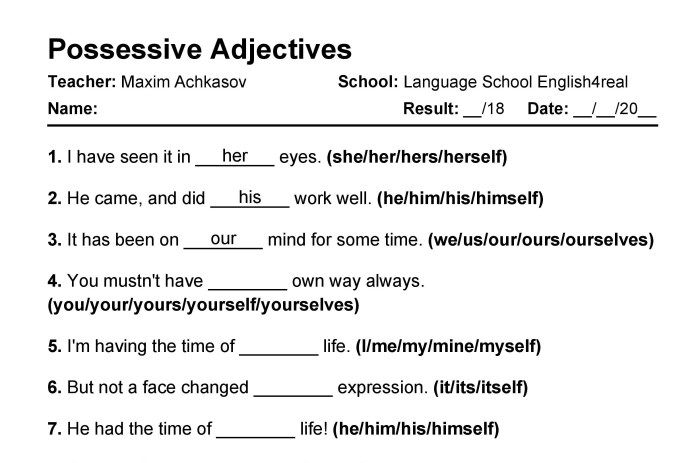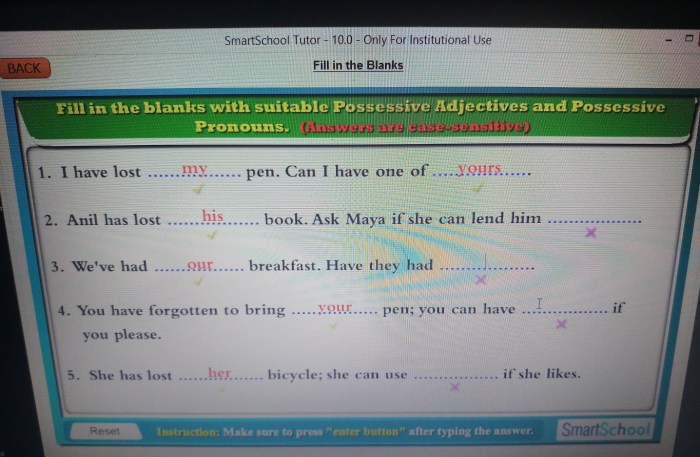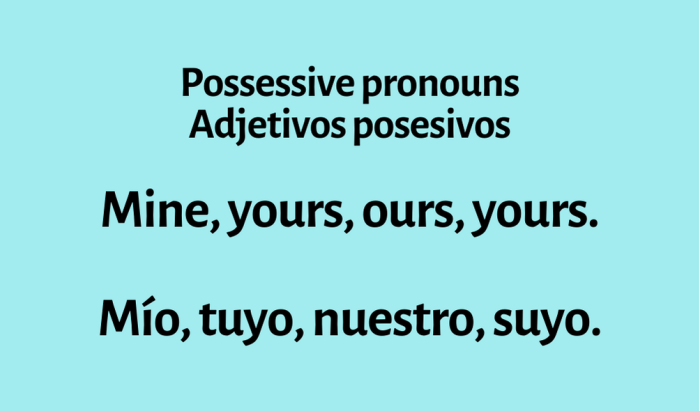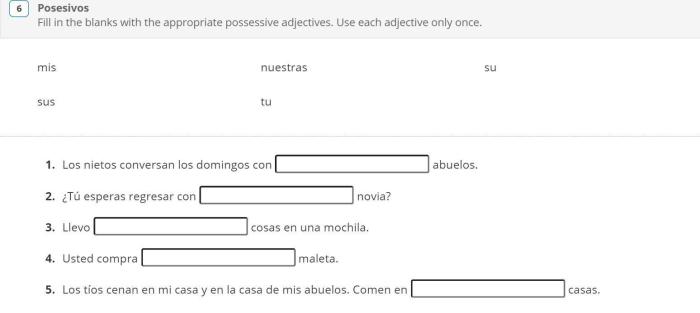Fill in the blanks with the appropriate possessive adjectives. – As Fill in the Blanks with the Appropriate Possessive Adjectives takes center stage, this opening passage beckons readers into a world crafted with meticulous care and scholarly precision, ensuring a reading experience that is both absorbing and distinctly original.
Delving into the intricacies of possessive adjectives, this guide provides a comprehensive overview of their usage in English grammar, elucidating their significance in indicating ownership or belonging. By delving into the various types of possessive adjectives, the rules governing their correct usage, and their application in diverse contexts, this guide empowers readers with the knowledge and skills necessary to navigate the nuances of possessive adjectives with confidence.
Possessive Adjectives in English Grammar

Possessive adjectives are words that indicate ownership or belonging. They are used before nouns to show that something belongs to a particular person, place, or thing. Using possessive adjectives correctly is essential for clear and concise communication in English.
Types of Possessive Adjectives: Fill In The Blanks With The Appropriate Possessive Adjectives.

There are two types of possessive adjectives in English: singular and plural. Singular possessive adjectives are used when the noun they modify is singular, while plural possessive adjectives are used when the noun they modify is plural.
- Singular Possessive Adjectives:my, your, his, her, its
- Plural Possessive Adjectives:our, your, their
It is important to note that the possessive adjective “your” can be used for both singular and plural nouns. When “your” is used with a singular noun, it indicates that the noun belongs to the person being addressed. When “your” is used with a plural noun, it indicates that the noun belongs to the people being addressed.
Using Possessive Adjectives in Sentences

Possessive adjectives are used to modify nouns and pronouns. They come before the noun or pronoun they modify and indicate ownership or belonging.
- Example 1:This is mybook.
- Example 2:The dog wagged itstail.
- Example 3:We love ournew home.
It is important to avoid using possessive adjectives with nouns that already indicate possession. For example, do not say “the boy’s his book” because the noun “boy” already indicates that the book belongs to him.
Possessive Adjectives in Different Contexts

Possessive adjectives are used in a variety of contexts, including formal writing, informal conversations, and legal documents. The usage of possessive adjectives may vary depending on the context.
- Formal Writing:In formal writing, possessive adjectives are typically used in their full form (e.g., my, your, his, her, its, our, your, their).
- Informal Conversations:In informal conversations, possessive adjectives are often shortened (e.g., my -> mine, your -> yours, his -> his, her -> hers, its -> its, our -> ours, your -> yours, their -> theirs).
- Legal Documents:In legal documents, possessive adjectives are typically used in their full form to ensure clarity and precision.
Helpful Answers
What are possessive adjectives?
Possessive adjectives are words used to indicate ownership or belonging of a noun or pronoun.
How do I use possessive adjectives correctly?
The usage of possessive adjectives depends on the person and number of the noun or pronoun being modified.
What are some common errors in using possessive adjectives?
Common errors include using the wrong form of the possessive adjective, using possessive adjectives with plural nouns, and using possessive adjectives with pronouns that already indicate possession.